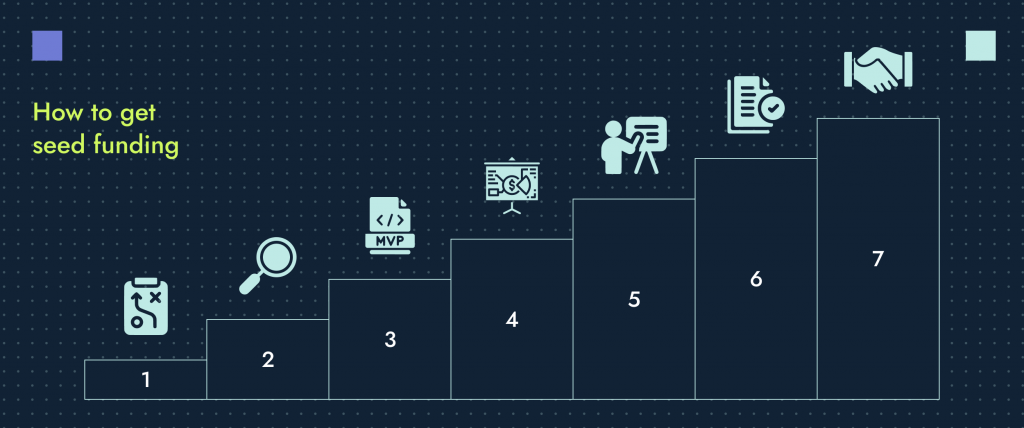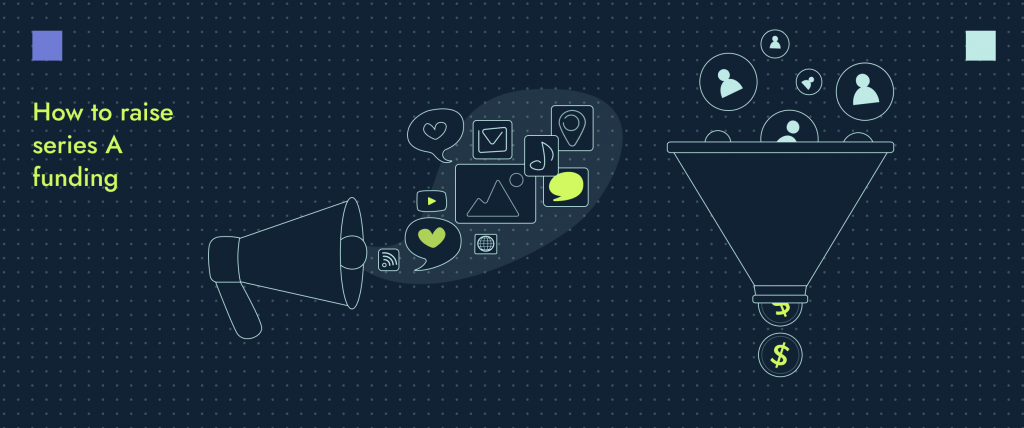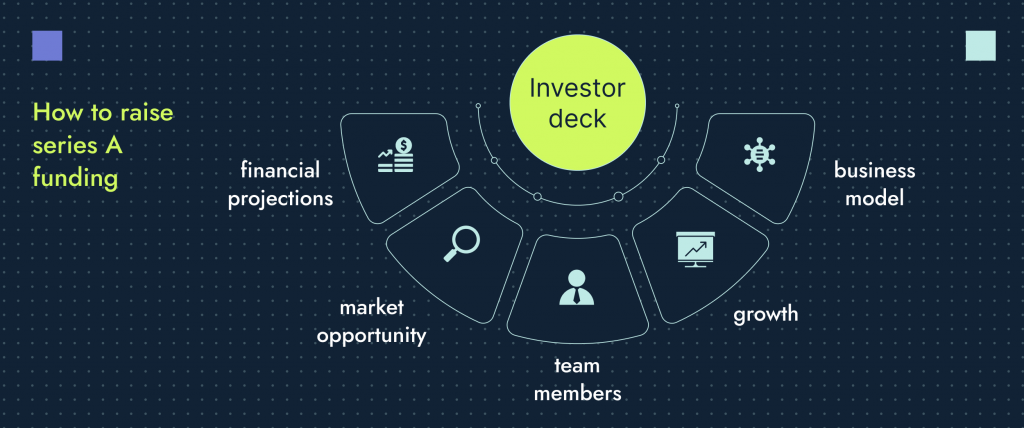It takes a lot of time and effort to bring even the most promising business idea to profitability. Most successful companies have had to raise a lot of outside capital along the way to grow faster, overcome financial roadblocks and maximize their chances of survival.
As a startup founder, you must also learn to navigate a maze of investment funding options and find the right fit for your company. Most startups undergo 2 initial investment rounds — seed funding and series A. Both rounds have different purposes, requirements and outcomes but play a crucial role in determining your startup’s future direction and progress.
This guide covers everything you need to know about seed vs series A funding, including examples, differences and common pitfalls.
What is seed funding?

Seed funding is the first round of investment funding for startups, usually provided by angel investors or early-stage venture capital (VC) firms. Founders can even raise a small amount of seed capital from sources close to them, such as friends, family and colleagues. It is called seed funding because this money provides the foundation or “seeds” for startups to develop.
Unfortunately, the seed stage is littered with the graves of failed startups. CB Insights, a business analytics platform, looked at 111 startup post-mortem reports and found that running out of cash and failing to raise funding was the top cited reason for failure.
A startup should seek to raise seed funding when it has already validated its market demand during the pre-seed phase and needs capital to build and scale operations. Raising seed funding also helps you assemble a dedicated founding team, improve the product and generate traction for future VC-backed investment rounds.
Types of seed funding
Equity-based funding
The most common type of seed-stage startup funding involves the founder(s) selling equity in the company in exchange for capital.
Convertible note seed funding
This type of funding allows an investor to loan money to the startup, with the ability to convert the loan into equity later. This method is a good option for startups that are not ready for valuation yet.
Startup accelerators and incubators
Startups may be eligible for grants from government agencies, foundations or incubator programs. The incubators are designed to nurture “disruptive” business ideas and operate on a flexible timeline. Accelerators are more fast-paced and geared toward startups that are ready to scale. Out of thousands of startup incubators and accelerators across the US, some stand out:
Crowdfunding platforms
A newer form of seed funding allows startups to raise money from large groups of people via online platforms. Popular crowdfunding platforms for startups include:
Bootstrapping
Although rare, some businesses can survive without outside investment. Bootstrapping means using the founders’ money or the company profits as seed funding to fuel future growth. Apple did it as a startup. So did Facebook for some time.
How to get seed funding

Here are the steps you can take to secure seed funding:
1. Develop a business plan
Have a well-defined vision of your product or service, target market and revenue model and create a roadmap to communicate that plan to investors.
📚Read: Business Model Generation
2. Conduct market research
Validate your business idea by researching the market and gathering data on target customers and competitors. Our recommendations for market research platforms are Semrush, Owler, Gartner, TrustRadius, G2 Reviews and Census Data sites.
3. Have a minimum viable product (MVP)
An MVP contains just enough features to attract early adopters and shows investors your startup has matured beyond the “idea phase.” Spotify, now worth $21.77 billion, started by creating an MVP in the form of a music-streaming desktop app with ads.
4. Create financial projections
Prepare realistic financial projections that include revenue, expenses and cash flow to demonstrate your business’s viability to potential investors. Make sure to give undivided attention to your total addressable market (TAM), serviceable available market (SAM) and service obtainable market (SOM) metrics, along with your realistic headcount and technology running costs per month.
5. Prepare a pitch deck
Create a visually appealing pitch deck that highlights your business plan, market research and financial data clearly and concisely. According to a DocSend report, investors spent 56% less time on decks that got funded — because those startups were able to quickly demonstrate how their solution connected with an obvious business problem. Here are some great pitch decks used to secure seed investments:
- Buffer (raised $500K in 2011 from 17 angel investors)
- Intercom (raised $600K in 2012 with 500 Startups and Digital Garage)
- Zestful (raised $1.2 million in 2019 with Bessemer Venture Partners and Matchstick Ventures)
6. Get ready for the due diligence
Be prepared to provide detailed information about your company, team, technology and finances to investors interested in funding your startup. Seed investments are high-risk, so angels and VCs will often use lawyers, accountants and investigators to verify everything.
Here are the typical items within the due diligence phase to be careful with:
- Virtual data rooms (VDRs): A VDR is a secure repository for all your documents and information and lets you control what is shared at each step of the process. Make sure to watermark all your material (you don’t want your sensitive information leaked) and include all the relevant details to make the process faster.
- Intellectual property (IP) ownership and protection: Technology startups need full control over their intellectual property, code, branding and domains. If you have IP protection or rights, investors will want to know how much coverage you have. What’s stopping a tech giant from copying your product and offering it for cheaper at scale? IP issues can be time-consuming to handle and may involve going to court.
- Legal documentation: Investors will examine every piece of paper that has anything to do with your legal structure. Expect to be asked to produce partnership agreements, patents, licenses and proof of good standing with government agencies.
7. Close the deal
Work with your legal team to negotiate favorable terms and close the seed funding deal. First-time founders often struggle with this step, so it’s best to refrain from negotiating in real-time. Give yourself ample time to consider all options instead of jumping at the first offer.
📚Read:
- Venture Deals: Be Smarter Than Your Lawyer and Venture Capitalist
- Never Split the Difference: Negotiating as if Your Life Depended on It
For a more in-depth look at the seed fundraising process, check out our complete guide.
Seed funding: Examples of successful startups
In 2009, Airbnb raised $600K in a seed round, primarily due to the disruptive nature of their platform and a fantastic pitch deck. They received $20K from Y-combinator (a startup incubator) and $585K from Sequoia Capital (a venture capital firm). Thanks to the clearly communicated business goals and financial incentives, the Airbnb pitch deck still serves as a template for many early-stage startups looking to secure funding.
Other examples of well-known companies that received seed funding to build their products, hire employees and grow their customer base include Zoom, Dropbox and Facebook. Peter Thiel, PayPal co-founder, was the only seed investor for Facebook, giving them $500K for 10.2% of the company shares in 2004, which he later sold for $1 billion.
Seed stage investors: High risk, high reward
Seed funding usually involves less scrutiny and legal obligations than later funding rounds. As a result, startups are free to explore and experiment with their business models. However, this also means the investment risk is higher.
Each type of seed investor has their own philosophy, risk tolerance and return on investment (ROI) expectations.
Angel investors
Angel investors are well-off individuals who provide seed funding to early-stage startups. They typically invest small amounts of money, have a higher risk tolerance than traditional investment firms and usually seek an early exit. Check these angels out:
- Gaingels: An angel group with 200 angel or seed round deals in 2022, including Binance.US and Gravitics.
- Elad Gil: Entrepreneur and angel investor, Elad Gil has seen some big-name exits from Airbnb, OpenDoor and Wish. He invested in 11 seed or angel rounds in 2022.
- Ashton Kutcher: Celebrity investor Ashton Kutcher’s mega-hit exits include Duolingo and Poshmark. His latest known investment was in QD-SOL’s angel round in June 2022.
Some websites and platforms help startups connect with angel investors. These platforms include AngelList, Angel Investment Network and Gust.
💡 According to Angel Capital Association, the number of angel-backed companies with female CEOs has risen dramatically from 5% in 2015 to 21% in 2019.
👉 Learn more about women in leadership roles and why that might be good for business.
Venture capital firms
VC firms generally aim to provide seed funding to startups with high perceived growth potential. They invest more significant amounts of money than angel investors and choose startups based on the technology and intellectual property behind the business. Take a look at these VCs:
- BoxGroup: A seed VC firm out of New York with a focus on technology startups in their early stages. They have made 598 investments since 2009 and have seen 106 exits.
- 8VC: A technology and life sciences investment firm based in San Francisco, California, that has made 403 investments and 31 exits since 2015.
Family offices
Family offices are investment firms that provide wealth management services to high-net-worth families. They may also provide seed funding to startups and often have a long-term investment plan. According to a PwC study, family office investments into startups increased by 48.9% in 2021, including 451 seed investments.
Here are some family offices that might be interested in investing in your startup:
- Celestial Ventures: A family office based in Houston, Texas, that invests mostly in, as the name suggests, space technology startups and technologies. Their last seed investment was $500K in a renewable energy startup.
- Acequia Capital: A family investment office in Seattle, Washington, with global investments in early-stage sustainable technology companies.
- Omidyar Network: A family office established by Pierre Omidyar, the billionaire founder of eBay, in 2004. The company’s investment arm has made 339 investments and 54 exits.
Angel investors vs venture capitalists: Which are better for startups?
Angel investors usually invest smaller amounts in earlier-stage companies and are hands-on with their investments by offering mentorship and support. These individuals use their own money and may have a personal network of contacts they can bring to the table. Angel investors are often former founders and CEOs with leftover capital to invest after a successful exit. Many “super” angels also form micro VC firms and funds solely to invest in early-stage companies.
On the other hand, VC firms manage money for a large pool of investors. Their focus is on maximizing financial returns and may require more control over a startup’s operations and decision-making. These firms have a large professional network and resource pool to leverage for the startups they invest in and usually set a defined timeline for ROI.
Startup founders and CEOs should carefully evaluate their needs, goals and the phase of their startup before choosing between types of investors. Other factors to consider are the terms of investment, your comfort level with these terms and your relationship with the investor.
💡 Always go for “smart money” (investors who have a record in growth), not just a bag of cash without support (since you most likely don’t know how to use it and will burn through it). And choose quality over quantity. Talking to more investors might get you more meetings, but your connection with each potential investor will ultimately decide how successful your seed round will be.
What is series A funding?

Series A funding is a startup company’s first significant round of capital investment, typically coming after seed funding. However, some experienced founders with a proven track record and startups in less experimental markets choose to jump straight to series A funding from VCs and skip the seed round altogether.
Series A funding aims to help the company continue to grow and scale, reach product development milestones and prepare for later funding rounds. Series A funding usually involves venture capital firms, but angel investors and family offices can still participate.
Unlike the seed stage, you can enter the series A round more confidently and expect to raise more capital for less equity. A startup team should consider raising series A funding when it can show solid growth and performance metrics and has publicly demonstrated that its business model and go-to-market strategies are viable. This demonstration includes confirmed market demand for the product or service, steady customer growth and a clear path to increased revenue generation.
How much is series A funding on average?
According to data from Fundz, US series A funding rounds in 2022 raised $22 million on average, with $15 million as the median. The amount of series A financing varies greatly depending on several factors, including the industry, product development stage and the company’s financial performance.
How to raise series A funding
Here are the steps you need to take for a successful series A funding round:
1. Establish customer traction and growth trajectory

Demonstrate traction and growth, such as increasing user numbers or revenue, to indicate to investors that your business has the potential to scale. Leverage social media platforms to get the word out and ask for reviews and feedback from current users.
2. Show product-market fit

Investors will look for evidence of a product that addresses a real need in the market, has a steady user base and can be profitable in the long run. Startups can use sales data, customer feedback and testimonials to prove product-market fit.
3. Grow your team

Show investors you are ready for the next stage by expanding and diversifying your founding team with the right talent that closes existing skill gaps. Being able to attract top talent also indicates to investors that other people are willing to bet on your company.
📚Read: The Hard Thing About Hard Things
4. Prepare a comprehensive investor deck

Create a detailed investor deck highlighting your business model, growth, team members, market opportunity and financial projections. In the seed round, a pitch deck shows what’s possible. In a series A round, investors are more interested in historical data and milestones you’ve completed. Take a look at these deal-winning series A pitch decks:
- Mattermark (a business data platform that raised $6.5 million in 2014)
- Front (a customer communication platform that raised $10 million in 2016)
5. Engage investors early
Identify and build relationships with potential series A investors with a history of investing in technology startups similar to yours. Seek their advice and start networking early to ensure that you have VCs already familiar with you and your company when the round starts.
Here are our favorite VC firms:
- Insight Partners: A private equity firm that invests in technology and software startups at every stage. Their portfolio includes monday.com and OneTrust, and they started the year by leading AtomicJar’s $25 million series A round.
- Tiger Global: An investment firm in the internet, software, consumer and fintech industries. Their overall series A round participation in 2022 was $458 million.
- General Atlantic: A private equity firm with $84 billion worth of assets under management. They participate in early and late investment stages, and their portfolio includes companies in the technology, financial services and healthcare sectors.
6. Refine your pitch
Remember that investors hear hundreds of pitches in a year, so you’ll need to stand out. Use storytelling to develop a narrative that clearly articulates your business idea, why now’s the right time to bring it to market and why you’re the best team to do it. If you can make it obvious to investors that the only thing hindering your company’s growth is a lack of capital, they’ll have their checkbooks out before the end of your presentation.
7. Be transparent
Be open and honest about your company’s financials, business model and future plans to build trust with potential investors. Be willing to give up a portion of your company’s equity and show investors that you have a plan in place to grow your business with future funding rounds.
What are examples of series A funding?
Uber
Uber raised their first funding, a series A round, in 2011 from investors including Benchmark Capital and First Round Capital. The company entered the negotiations with a pre-money valuation of $45 million and managed to raise $11 million. The funds were primarily used to expand into new markets and regions.
Slack
Slack is a popular workplace communication platform founded in 2013. The company raised $5 million in its series A funding round, backed by Accel, Andreessen Horowitz and other partner investors.
Transmit Security
In 2021, Transmit Security, a password-less authentication cybersecurity company, managed to raise a record-breaking $543 million in a series A funding round led by Insight Partners and General Atlantic. Investors saw the potential benefits of biometric authentication for enterprises and handed them a pre-money valuation of $2.3 billion.
Armis Security
Armis, a cybersecurity company focused on asset discovery and visibility, raised $17 million in its 2017 series A round led by Sequoia Capital and Tenaya Capital.
Within 3 years of their go-to-market efforts, the company reached a $1 billion valuation and was acquired by Insight Partners. Despite already reaching unicorn status, Armis continued to scale and, thanks to its unique position in the industry, was able to more than double its billion-dollar valuation by 2021 and close the year off with an additional $425 million in funding.
Series A funding vs seed: What’s the difference?
After understanding the purpose and procedure of these early-stage investment rounds, it is useful to detail the differences between them for a startup team looking to secure funds.
The table below illustrates key differences in some aspects of the two funding rounds:
| Aspect | Seed funding | Series A funding |
|---|---|---|
| Objective | Seed money is used to support the early steps of a startup’s development, such as conducting market research and building a founding team. | Series A supports the growth and expansion of a startup that has already established its product-market fit. |
| Product and traction | Seed rounds don’t necessarily require a finished ready-for-market product, but having an MVP is a good idea | Series A funding comes after there is already a product and obvious traction. |
| Amount of capital | Seed funding is usually the first round of funding and raises a small amount of capital. | In series A, the startup receives more capital to support future growth. |
| Valuation and investment risk | Seed funding results in lower pre-money valuations because of the high investment risk. | Series A funding has higher valuations because of less investment risk. |
| Financial projections | Seed investors may be more flexible with their expectations and may invest in a startup without established financial targets. | Series A investors expect to see financial milestones, such as revenue growth, customer acquisition and positive cash flow. |
| Ownership percentage | Because investors take on a higher risk investment, founders usually lose a larger chunk of their startup during seed rounds. | With an already up-and-running startup, founders can retain more equity in series A rounds. |
| Exit strategy | The seed funding rounds are focused on getting the business to the series A stage. | The series A funding rounds focus on growth, meeting objectives and surviving until the next fundraising round. |
The common pitfalls of early-stage funding rounds
Here are some common mistakes to avoid during your early-stage investment rounds:
❌ Overfunding and underfunding
Overfunding can be just as risky as underfunding. A company’s post-money valuation is calculated after considering outside capital injections. When startups take on too much funding, they may become overvalued and have difficulty reaching their target milestones, making it harder to attract additional investors in later funding rounds. They generally don’t like a business that looks like it stumbled and needs follow-up funding.
On the other hand, being underfunded would mean you risk running out of cash and failing to make it to the next investment round altogether.
❌ Giving up too much equity
The initial rounds require having the right timing and finding a balance between the control you give up and the amount of capital you need to grow your business. However, you do not want to let go of too much equity. You still want to be able to use it as a bargaining chip in later investment rounds. Eventually, you will have to dilute ownership, but avoid doing it too fast.
❌ Focusing only on equity
Many founders, understandably, obsess over retaining as much equity as possible. They forget that even with the majority of shares, they can still lose control over the company, thanks to corporate structures and voting rights. While it is important to retain equity, it shouldn’t stop you from getting a good deal. You should also weigh the investor terms against other factors, including the amount of capital you’ll need to survive till the next round, the connections and resources an investor is offering and the impact of the early-stage funding on the company valuation for future rounds.
❌ Making it all about fundraising
Don’t forget the business you have to run and the product you need to improve. There’s also the team burning the midnight oil to reach milestones while you meet investors and prepare for one round after the other.
Startup founders can get caught up in the fundraising process. While raising funds may be necessary for many companies, there are also plenty of startup success stories that were able to become profitable without any outside investments. Establishing a business requires a mix of intelligent decision-making, the right connections and some luck. So be patient, build your team and network and look for opportunities while improving and refining your product and business model.
Series A vs seed round: Expected growth and next steps
Seed funding
The seed round funds typically go into product development, hiring new team members and some initial market research to validate your product direction and current business model.
The post-seed stage is where most startups find that either their timing is off, they’ve run out of cash too soon or their business isn’t scalable enough to secure future investments. According to Crunchbase, you have 1 out of 3 odds of making it to your series A round.
There is still hope, however. Some startups may find that all they needed was seed funding to get off the ground and reach profitability. Shopify, one of the biggest ecommerce platforms, started as a shopping cart solution for an online snowboarding equipment store built using Ruby on Rails. The company ran on generated revenue for 6 years before accepting $7 million in a series A round.
Series A funding
Series A is the first round of venture capital, and the influx of cash is used to scale operations, ramp up marketing efforts and expand your workforce. The series A round should ideally provide you with enough working capital to reach most development and growth milestones needed to enter the next round of funding. Series B investors will want to see metrics and benchmarks on what you accomplished with series A capital, so keep an eye on your annual recurring revenue (ARR), growth rate and customer acquisition and retention metrics.
Getting B2B marketing right as an early-stage tech startup
You’ve made it past series A, developed a fantastic product, assembled a world-class team and have a solid business model to monetize all your hard work. But there’s just one problem. Your marketing budget is small compared to some of the older players in the industry, and your online footprint is non-existent. The customers you created your product for don’t even know you exist, and you need good customer acquisition numbers to show in the next investment round.

That’s where we come in. As a B2B marketing consultancy, we partner with technology startup teams to run fast-paced search engine optimization (SEO) campaigns that yield tangible ROI results and attract high-quality leads. We understand that most of your funding went to the product and technology teams.
Our team of SEO specialists, web developers and content writers can still jump in to improve your website’s technical performance and produce a steady stream of B2B marketing content that ranks in search. We can help you educate and introduce customers to new categories for disruptive technology solutions or establish yourself as a thought leader in existing overcrowded markets.






